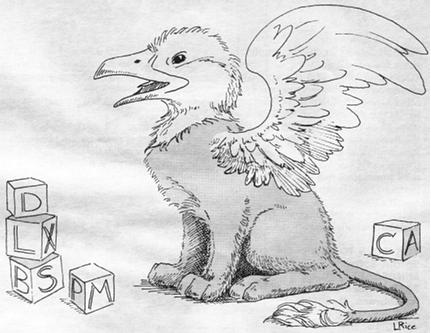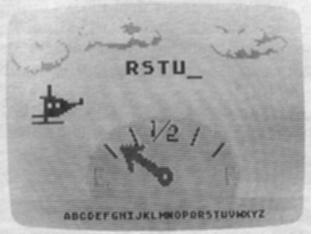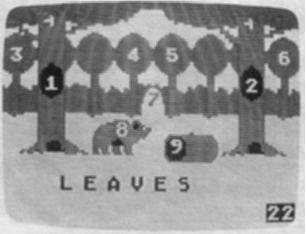

In ANALOG Computing's issue 24, I reviewed an exceptional educational game from Sprout Software, called Tonk in the Land of Buddy-Bots. Now, two additional programs are available in the TinkTonk series of educational software designed for children of ages four to eight years. While maintaining the same high level of quality, these new games have an even greater educational thrust.
TINK'S ADVENTURETink is the trusty leader of the TinkTonks and is about to embark on an adventure. As Tink arrives on foot at TinkTonk Lake, he has the choice of continuing the adventure by helicopter or boat. Having selected the means of transportation, one is given the chance to play a game or begin the adventure.
At various junctures, similar options appear, providing the opportunity to play one of seven games included in the adventure. Most of these games have educational value, but two of them, Pilot Boat and Fly Helicopter, are included just for fun.
Using the keyboard, one may pilot the boat around the islands in TinkTonk Lake or fly the chopper through the sky in front and back of islands, clouds and even stars. These activities have no bearing on the course of the adventure, but simply provide a pleasant little interlude.
The Other five games are designed to help children learn ABC order and to familiarize them with the computer keyboard. In Get Gas, four consecutive letters of the alphabet are displayed with a blank at the beginning or the end of the sequence, depending on the option one has chosen.
The level of difficulty may be selected as hard, where ten correct answers are required to fill the helicopter's tank. This task is made easier with a display of the complete alphabet at the bottom of the screen. A harder level requires twenty correct answers without the benefit of the alphabet display, There is no time limit, and incorrect answers are ignored and incur no penalty.
This game provides an opportunity for the young child to arrive at an answer, whether from the screen display or the time-honored "mental recitation," while exploring the keyboard without the pressure of time or the fear of being wrong. The development of speed and accuracy in the learning process is important, but before this can be achieved, the basic information must be assimilated without stress.
In Go Fishing, children get to know the computer keyboard. The keyboard is divided into four designated areas: the top row of numbers, and the left, center and right portions of the remaining keyboard area.
After a specific area is chosen, or the entire keyboard, if desired, the size of the fish is selected - from one to five characters long. Finally, one of three speeds is chosen, determining how fast the fish will swim.
As the combinations of characters pass beneath the boat, they are reeled in by reproducing them exactly as shown, before they disappear from the screen.
All the necessary levels of progression are provided to establish proficiency on the keyboard. Anyone able to snag all twelve fish of the largest size (five characters) at the fastest speed is a whiz. I cannot come close to doing it.
While cruising around the lake, Tink's boat may spring a leak and can be saved only by playing Sinking Boat.
Another game emphasizing the keyboard, this one requires the player to type in the missing letter or number of a series of characters that are displayed in the same sequence as they appear on the computer keyboard.
A trip to Davy jones's locker can be avoided with five correct answers within one of three preselected time limits - fifty-five seconds, thirty-three seconds or ten seconds.
If the boat sinks, all is not lost, since further opportunities to play the game and save the boat are provided. Even total failure does not stop the adventure, but more on that later.
Eventually, Tink lands on a large island and, while exploring its secrets, suddenly finds himself being harassed by a gorilla who's throwing coconuts from the top of a palm tree. Sounds like time to play Coconut Catch, eh?
Three-letter alphabet sequences are displayed on the screen with a blank in the middle. If the correct letter is supplied before the coconut hits the ground, it becomes part of a pyramid.

The first level gives one twelve tries to build a pyramid out of ten coconuts. The harder level requires one to build a fifteen-coconut pyramid with eighteen tries, and the hardest level gives twenty-five tries to assemble a pyramid from twenty-one coconuts.
The last game is played when Tink's search leads him to Gork's Treasure. Here, one can practice ABC order alone, or ABC order and keyboard sequences mixed together.
A five-character sequence displays, with one of the spaces blank. With ten correct answers in a row, Gork disappears, and the treasure is won.
In the fast level, one has six seconds to enter the correct response. In the faster and fastest levels, this time limit is four seconds and two seconds, respectively.
The overall design of Tink's Adventure is excellent. The adventure theme adds a bit of excitement without the threat of danger. If the helicopter runs out of gas and plunges into the water, or if the boat sinks, Tink, the Indiana Jones of TinkTonk Land, laughs in the face of danger and prevails.
There always seems to be a raft or friendly whale around to get Tink to the island and continue the adventure. If one fails to accomplish a task the first time, additional opportunities are provided, if desired, or one can simply continue the adventure.
Clever graphics and straightforward on-screen instructions complement each other. One of the highlights of this package is the distinctive music which accompanies Tink on his adventure. From the lively, upbeat melody as the adventure begins to the chillingly haunting theme while following Gork's tracks, a mini sound track has been created - the perfect cherry with which to top the dessert.
The educational objectives are sound, and the methods used are right on line.
TUK GOES TO TOWNThe basic format in this game is similar to Tink's Adventure. Tuk, the gardener in TinkTonk Land, makes a trip to town with plenty of stops along the way. During this excursion, any of seven games may be played.
Tuk can travel to town by motorcycle, train, speedboat, or any one of eight possible modes of transportation. On his way, Tuk can travel through the farm, fair, forest or seashore, each with its own special game.
Once in town, visits to the three different stores provide additional games to be played. The educational objectives of the games comprising Tuk Goes to Town promote the development of visual discrimination skills, provide practice with spelling and help to build a larger vocabulary.
The Farm game requires the player to unscramble the letters of either animal names or farm words. A picture of the animal is displayed above each letter, and a correct response makes the animal jump into the pen. No penalty is assessed for incorrect keyboard entries, and an unlimited number of attempts is permitted.
The Fair game is described as "Just for fun," but, in fact, visual discriniination skills will be enhanced, particularly in younger children.
The game itself uses a shooting gallery, the targets consisting of a row of ducks. A variety of shapes move across the screen just below the ducks. In the center of the screen is a stationary group of three to five shapes, which are to be matched from left to right when their counterpart appears in the target sight immediately under the duck. The player is provided with a limited number of bullets to shoot down the ducks.

The Forest game is the most difficult and the most fun of all the games. Different shapes or letters are hidden in the forest. Numbers from one to nine are used to designate the hiding places.
In "hidden shapes," a series of different shapes is displayed on the screen. A number in the lower right-hand corner of the screen denotes the number of attempts allowed to match these shapes. A free "peek" is given at the beginning, to see where the shapes are hiding. The shapes are matched from left to right, with each key pressed counting as one attempt.
In "hidden letters," the object is to find the letters of a common forest word. Memory and concentration skills are exercised in this game.
Arriving at the Seashore, Tuk needs help to win a boat race. The player is presented with either a scrambled word or a word with missing vowels. In either case, with each correct entry, Tuk's boat moves closer to the finish line.
Another boat, the competition, moves steadily toward the finish at one of two selected speeds. If all of the necessary letters are entered quickly enough, Tuk will win the race. Increasing the player's vocabulary and providing spelling practice are the goals of this game.
Once Tuk gets to town, there are three stores for him to visit. These are games which stress pattern and shape recognition.
In the Toy Store, a group of eight wrapped packages is displayed, with a letter beneath each one. One of the packages differs from the others, and when the corresponding letter is pressed, it fills one of the blank spaces of the Toy Store word being sought. The packages change after each entry.
The Market game consists of two activities which emphasize the development of similar skills. In "match the shapes," a series of shapes is displayed on the left side of a balance scale. At the bottom of the screen, several shapes are shown with letters in them. Matching a shape on the scale with the right one from the bottom places the respective letter on the right side of the scale. The scale is balanced when the correct market word is spelled out. As many tries as needed are permitted.
In "find the word," only half the shape to be matched is shown on the scale, making it a little more difficult.
The Clothes Store game is another of those just for fun. By selecting one of six styles of hats, pants, shirts and shoes, one can dress Tuk in a variety of fashionable togs.
As with Tink's Adventure, the design features of this program are superb. With a little more emphasis on spelling and vocabulary, Tuk Goes to Town is as stimulating for older children as it is for younger ones. The TinkTonks are quite capable companions for these adventures into education.